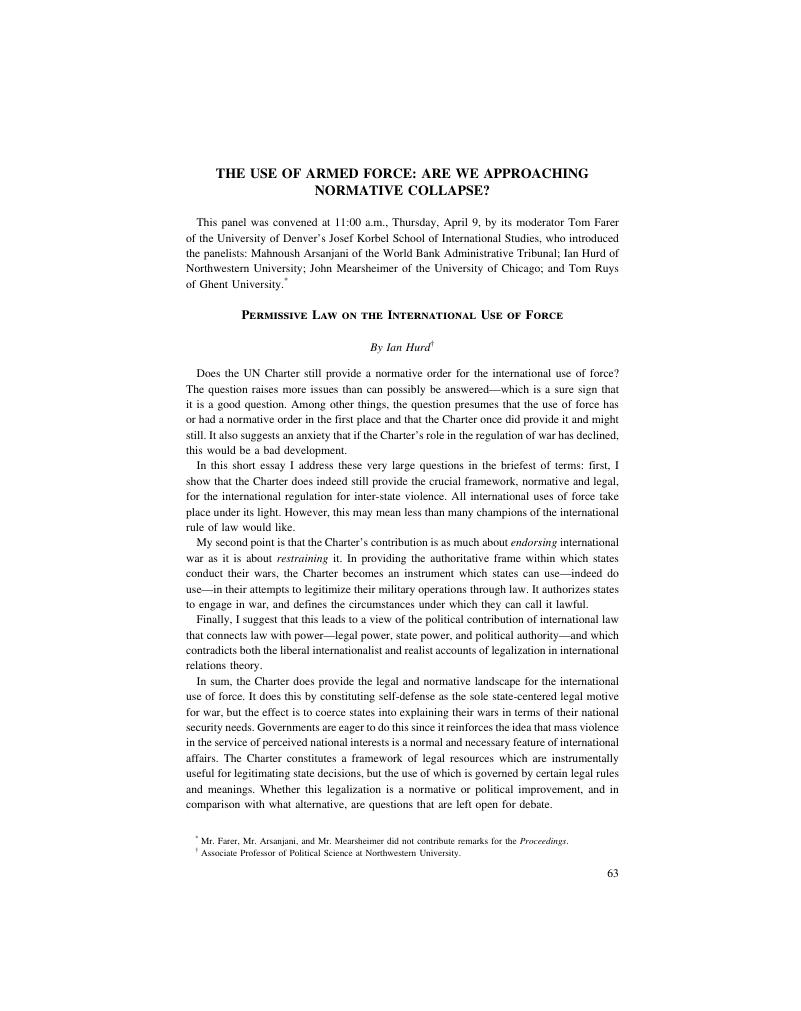No CrossRef data available.
Article contents
Permissive Law on the International Use of Force
Published online by Cambridge University Press: 20 January 2017
Abstract

- Type
- The Use of Armed Force: Are We Approaching Normative Collapse?
- Information
- Copyright
- Copyright © American Society of International Law 2016
References
* Mr. Farer, Mr. Arsanjani, and Mr. Mearsheimer did not contribute remarks for the Proceedings.
1 On informal amendment of the Charter, see Hurd, Ian, Security Council Reform: Informal Membership and Practice, in The Once and Future Security Council (Russett, Bruce ed., 1997)Google Scholar. On the legality of humanitarian war, see Thomas Franck, Recourse to Force: State Action Against Threats and Armed Attacks Ch. 10 (2002) and Hurd, Ian, Is Humanitarian Intervention Legal? The Rule of Law in an Incoherent World, 25 Ethics & Int’l Aff. (Summer 2011)Google Scholar.
2 Franck, Thomas, Who Killed Article 2(4)? Or: Changing Norms Governing the Use of Force by States, 64 AJIL 809, 810 (1970)Google Scholar.
3 Michael Glennon, Why the Security Council Failed (2003).
4 Peter Cane, Responsibility in Law and Morality (2002). Scott Veitch, Law and Irresponsibility: on the Legitimation of Human Suffering (2007).
5 Andrew Guzman, How International Law Works: A Rational Choice Theory (2007).
6 Scott Veitch, supra note 4.
7 I side with Louis Henkin in his exchange with Thomas Franck in 1970-71 over the political impact of the ban on war. Henkin, Louis, The Reports of the Death of Article 2(4) are Greatly Exaggerated, 65 AJIL (1971)Google Scholar; Thomas Franck, supra note 2.
8 Steinberg, Richard, Wanted—Dead or Alive: Realism in International Law, in Interdisciplinary Perspectives on International Law and International Relations: The State of the Art (Dunoff, Jeffrey L. & Pollack, Mark A. eds., 2013)Google Scholar.
9 See, e.g., John J. Mearsheimer, The Tragedy of Great Power Politics (2014, updated); Ian Hurd, IL/IR Book Discussion: Comment on Richard Steinberg, “Wanted Dead or Alive: Realism in International Law,” Opinio Juris (Sept. 16, 2013, 12:30PM EDT), http://opiniojuris.org/2013/09/16/ilir-book-discussion-comment-on-steinberg/. Hurd, Ian, Constructivism, in The Oxford Handbook of International Relations (Reus-Smit, Christian & Snidal, Duncan eds., 2008)Google Scholar.
10 Hurd, Ian, The International Rule of Law and the Domestic Analogy, 4 Global Constitutionalism (2015)CrossRefGoogle Scholar.
11 Taylor, Charles, To Follow a Ruleo, in Bourdieu: Critical Perspectives (Calhoun, Craig, LiPuma, Edward, & Postone, Moishe eds., 1993)Google Scholar. Ingo Venzke, How Interpretation Makes International Law: On Semantic Change and Normative Twists (2014).
12 Jack L. Goldsmith & Eric A. Posner, The Limits of International Law (2006).
13 Steinberg, supra note 8.
14 Brian Tamanaha, On the Rule of Law: History, Politics, Theory (2004).


